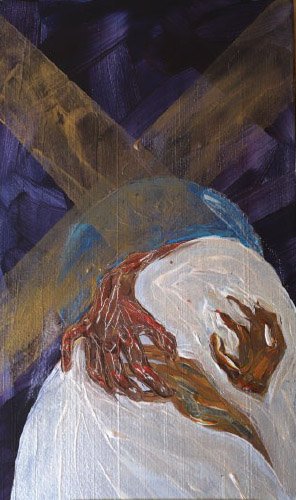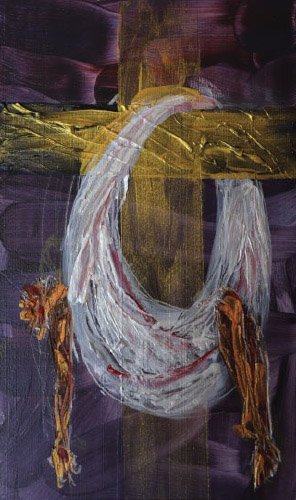Art and Soul and Fr. Rey
/Fr. Rey Culaba (Photo by Debra Greenblat)
As a child, his parents allowed the children to draw everywhere, and his father even gave each child a sketchpad. His mother was very creative. His older sister, Elenita, studied Fine Arts at the University of Santo Tomas, and in turn, she taught the younger children about art, but discouraged them from pursuing it as a career.
Fr. Rey Culaba as a Philosophy student in Australia with a commissioned portrait of St. Camillus De Lellis for the Hospitalier Brothers.
His religious, pastoral and spiritual journey started on December 16, 1972 when he was ordained. Since then, Fr. Rey (as I fondly call him) has preached and given retreats in rural communities in the Bicol region, Batangas, and Quezon provinces in the Philippines. In 1981, for his sabbatical, he enrolled at the Institute for Spirituality and Worship at the Jesuit School of Theology in Berkeley, California. A course on Psalms and the Song of Songs with Fr. William Fulco, a Jesuit, confirmed his artistic talent. The class would do a weekly reflection and Fr. Rey submitted a written one and a reflection in art of the same subject. Fr. Fulco told him to forget about the written reflection and just concentrate on the art. Fr. Rey received a grade of A+ for this course.
He was on his way back to the Philippines in 1983 when former Senator Ninoy Aquino was assassinated. Fr. Jim Goode, pastor of St. Paul of the Shipwreck parish in San Francisco, was looking for a Filipino priest to celebrate Mass in honor of Aquino. Fr. Rey stayed not only for the Mass, but for 12 years, tending to the needs of the parishioners who were mostly African American, and finding a best friend and brother in Fr. Jim. [Ed note: Fr. Jim Goode passed away last March 4, 2022.]
Fr. Rey at a rally in Union Square, San Francisco in 1986 celebrating the downfall of the dictator, the former President Ferdinand Marcos. (Photo by Rick Rocamora)
Fr. Rey was then sent to Portland, Oregon but after only a short stay, he was asked to go to Italy to tend to the growing numbers of overseas Filipino workers (OFWs). His “mission” area included Rome, Parma, Venice, and Palermo. He stayed for six years and became a constant friend, confidant and spiritual adviser to Filipinos who were working hard and missing their families. He says the period in Italy was one of the most rewarding years of his career. Back in the Philippines, he had stints as rector of a seminary and a missionary in Ilocos Norte. He was also assigned to teach English in Vietnam.
Upon his return to the U.S. he helped out at the Holy Angels Church in Colma, California until they found an associate pastor. It was at this church that Jeanine de Rivera, a resident of Daly City, remembers hearing for the first time Fr. Rey say Mass at 7:30 a.m. some years ago.
“His deep tones, his words, had a way of drawing you within. He seemed to have experience in guidance or spiritual direction. His pauses were just right, to get you into a reflective mood. He prayed and spoke from his heart like he was speaking to just me. I listened more closely. My sleepiness melted away.”
“Jesus’ physical and emotional pain and suffering really jumps out from the paintings, just like Fr. Rey’s homilies.”
De Rivera was so impressed that she made a mental reminder to get to know “this man.” A few months later, the parish priest of nearby Our Lady of Mercy, Fr. Doming Orimaco, mentioned to De Rivera that he needed a priest in residence to help out in the parish, and De Rivera remembered Fr. Rey. It turned out Fr. Doming knew Fr. Rey and thought he would be a good fit for the parish. Fr. Rey is currently a priest in residence at Our Lady of Mercy (OLM) in Daly City, California. But everywhere Fr. Rey went, his pen and brushes, sketches, illustrations, designs and paintings were never far behind.
At OLM, he noticed that the pictures of the Stations of the Cross were peeling off and decided to replace these pictures with his original acrylic paintings. It was his gift to the parish for his 50th anniversary in the priesthood. It took him three months to do the project, painting on and off “as the Spirit moved. My inspiration was the painting done by my founder, St. Alphonsus de Ligori (17th century) of the Crucifixion,” he says. “In fact, St. Alphonsus, who was also an artist, composer, writer, Moral Theologian (a Doctor of the Church), was my inspiration on how to integrate one’s gifts to one’s life, as a priest and as a religious.”
Crucifixion by St. Alphonsus de Ligori.
Fr. Rey’s fourteen paintings on the Via Dolorosa, Way of Sorrow or commonly known as the Stations of the Cross will be placed around OLM’s parking lot, in time for Lent. He adds subtexts to some stations so that the viewer can further reflect on these stations.
1st Station of the Cross – Jesus is Condemned to Death. (Photo by Debra Greenblat) (The actual painting on the left and the painting mounted at OLM’s parking lot.)
2nd Station of the Cross – Jesus Takes up His Cross. Embracing the Cross (Photo by Debra Greenblat)
3rd Station of the Cross – Jesus Falls the First Time. (Photo by Debra Greenblat)
4th Station of the Cross – Jesus Meets His Mother. Tenderness (Photo by Debra Greenblat)
5th Station of the Cross – Simon of Cyrene Helps Jesus Carry His Cross. Burden Shared, Burden Lightened, THE DANCE (Photo by Debra Greenblat)
6th Station of the Cross – Veronica Wipes the Face of Jesus. Tenderness (Photo by Debra Greenblat)
7th Station of the Cross – Jesus Falls the Second Time. (Photo by Debra Greenblat)
8th Station of the Cross – Jesus Meets the Women of Jerusalem. Weep not for me but for your Children and Mother Earth. (Photo by Debra Greenblat)
9th Station of the Cross – Jesus Falls the Third Time. (Photo by Debra Greenblat)
10th Station of the Cross – Jesus is Stripped of His Clothes. The Violence Wrought upon God’s Beloved Daughters and Sons. (Photo by Debra Greenblat)
11th Station of the Cross – Jesus is Nailed to the Cross. (Photo by Debra Greenblat)
12th Station of the Cross – The Crucifixion. (Photo by Debra Greenblat)
13th Station of the Cross – Jesus is Taken down from the Cross. Sa Ugoy ng Duyan (The Rocking of the Cradle). (Photo by Debra Greenblat)
14th Station of the Cross – Jesus is Laid in the Tomb. The Empty Tomb. (Photo by Debra Greenblat)
His superior at OLM, Fr. Doming Orimaco, says, “Fr. Rey is a gifted artist. It’s really nice to have this in time for Lent…..Fr. Rey is very much appreciated here in the parish.”
Parishioners of OLM Les and Tess Lamug say that although the paintings are abstract, “Jesus’ physical and emotional pain and suffering really jumps out from the paintings, just like Fr. Rey’s homilies. He has shared his gifts of bringing God’s word to life, singing His praise (he is also a good singer) and giving glory to God through his artwork.”
Jeanine and her husband, Teddy, say Fr. Rey’s Stations of the Cross makes you think. “The emotions felt from each story told of the Passion of Christ. There is agony, there is injustice, there is suffering, and all the evil and ugliness our dear Lord was subjected to because of our sins. The scratches on the wood like nails or deep thorns cut onto Jesus’s flesh (Station 12) were deliberately textured for its brutality. The urgency of the strokes, the contrast of the colors and textures chosen, the grimness, the desperation, the cries……We were also struck with the interpretation of ‘Jesus meeting the women of Jerusalem’ resonating with the present issue of taking care of Mother Earth……Fr. Rey is an example of how we should follow in Christ’s footsteps.”
When asked how he feels about his art being displayed, he said, “If even ONE picture could move people to meditate on the Passion, Death, and Resurrection of Jesus and also to be in solidarity with the sufferings of others -- the judged, the condemned, the fallen, the trafficked and stripped of their human dignity, the sick and the dying -- I would feel that I've done something with my art for others and for God. It ends with the 14th Station and the HOPE of the Resurrection. EMPTY TOMB for those who make the Stations Journey -- that they will also rise and walk out from their tombs of sadness, depression, and hopelessness.”
Fr. Rey is the first to tell you that the life of a priest is not a bed of roses. “It has real thorns.” But he takes the hardships “in stride as being part of my missionary vocation.” He remembers what his former Novice Master, Fr. Patrick “Paddy” Deane, CSsR, told him on the day of his ordination: “Rey, the door is always wide open, if you decide to leave. It is harder to stay. You have to make a commitment every day to remain faithful.”
And indeed, Fr. Rey has remained faithful for 50 years.





















